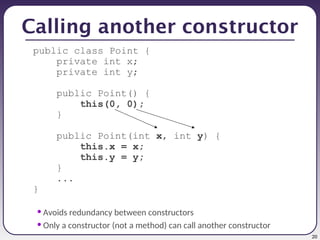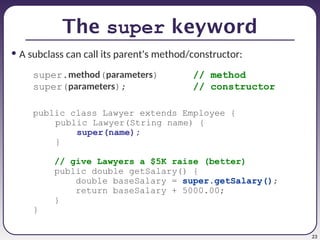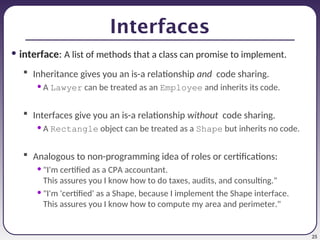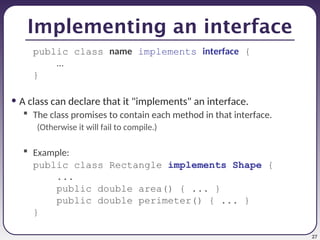01-introductionto Object ooriented Programming in JAVA CS.ppt
- 1. 1 CSE 331 Introduction; Review of Java and OOP slides created by Marty Stepp based on materials by M. Ernst, S. Reges, D. Notkin, R. Mercer, Wikipedia http://www.cs.washington.edu/331/
- 2. 2 What is this course about? • specification and documentation • object-oriented design taking a problem and turning it into a set of well-designed classes • testing, debugging, and correctness • learning to use existing software libraries and APIs • using software tools and development environments (IDEs) • working in small groups to solve programming projects • things that are "sort of" course topics: Java language features graphical user interfaces (GUIs)
- 3. 3 Building Good Software is Hard • large software systems are enormously complex millions of "moving parts" • people expect software to be malleable software mitigates the deficiencies of other components • we are always trying to do new things with software relevant experience is often missing • software engineering is about: managing complexity and change coping with potential defects • customers, developers, environment, software
- 4. 4 Managing Complexity • abstraction and specification procedural, data, control flow why they are useful and how to use them • writing, understanding, and reasoning about code the examples are in Java, but the issues are more general • program design and documentation the process of design; design tools • pragmatic considerations testing debugging and defensive programming
- 5. 5 Prerequisite knowledge To do well in this course, you should know (or quickly review): basic Java syntax (loops, if/else, variables, arrays, parameters/return) primitive vs. object types; value vs. reference semantics creating classes of objects (syntax and semantics) • fields, encapsulation, public/private, instance methods, constructors • client (external) vs. implementation (internal) views of an object • static vs. non-static inheritance and interfaces (basic syntax and semantics) Java Collections Framework (List, Set, Map, Stack, Queue, PriorityQueue) • using generics; primitive "wrapper" classes exceptions (throwing and catching) recursion see Review slides on course web site, or Core Java Ch. 1-6, for review material
- 6. 6 OOP and OOD • object-oriented programming: A programming paradigm where a software system is represented as a collection of objects that interact with each other to solve the overall task. most CSE 142 assignments are not object-oriented (why not?) many CSE 143 assignments are object-oriented • but not all are well-designed (seen later) most software you will write after CSE 143 is object-oriented • exceptions: functional code; systems programming; web programming
- 7. 7 Major OO concepts • Object-oriented programming is founded on these ideas: object/class: An object is an entity that combines data with behavior that acts on that data. A class is a type or category of objects. information hiding (encapsulation): The ability to protect some components of the object from external entities ("private"). inheritance: The ability for a class ("subclass") to extend or override functionality of another class ("superclass"). polymorphism: The ability to replace an object with its sub-objects to achieve different behavior from the same piece of code. interface: A specification of method signatures without supplying implementations, as a mechanism for enabling polymorphism.
- 8. 8 Object-oriented design • object-oriented design: The process of planning a system of interacting objects and classes to solve a software problem. (looking at a problem and deducing what classes will help to solve it) one of several styles of software design • What are the benefits of OO design? How do classes and objects help improve the style of a program? What benefits have you received by using objects created by others?
- 9. 9 Inputs to OO design • OO design is not the start of the software development process. First the dev team may create some or all of the following: requirements specification: Documents that describe the desired implementation-independent functionality of the system as a whole. conceptual model: Implementation-independent diagram that captures concepts in the problem domain. use cases: Descriptions of sequences of events that, taken together, lead to a system doing something useful to achieve a specific goal. user interface prototype: Shows and describes the look and feel of the product's user interface. data model: An abstract description of how data is represented and used in the system (databases, files, network connections, etc.).
- 10. 10 Classic OO design exercise • A classic type of object-oriented design question is as follows: Look at a description of a particular problem domain or software system and its necessary features in high-level general terms. From the description, try to identify items that might be good to represent as classes if the system were to be implemented. Hints: • Classes and objects often correspond to nouns in the problem description. Some nouns are too trivial to represent as entire classes; maybe they are simply data (fields) within other classes or objects. • Behaviors of objects are often verbs in the problem description. • Look for related classes that might make candidates for inheritance.
- 11. 11 OO design exercise What classes are in this Texas Hold 'Em poker system? 2 to 8 human or computer players Computer players with skill setting: easy, medium, hard Each player has a name and stack of chips Summary of each hand: • Dealer collects ante from appropriate players, shuffles the deck, and deals each player a hand of 2 cards from the deck. • A betting round occurs, followed by dealing 3 shared cards from the deck. • As shared cards are dealt, more betting rounds occur, where each player can fold, check, or raise. • At the end of a round, if more than one player is remaining, players' hands are compared, and the best hand wins the pot of all chips bet.
- 12. 12 OO design exercise What classes are in this video store kiosk system? The software is for a video kiosk that replaces human clerks. A customer with an account can use their membership and credit card at the kiosk to check out a video. The software can look up movies and actors by keywords. A customer can check out up to 3 movies, for 5 days each. Late fees can be paid at the time of return or at next checkout.
- 14. 14 Fields • field: A variable inside an object that is part of its state. – Each object has its own copy of each field. • Declaration syntax: private type name; – Example: public class Point { private int x; private int y; ... }
- 15. 15 Instance methods • instance method (or object method): Exists inside each object of a class and gives behavior to each object. public type name(parameters) { statements; } same syntax as static methods, but without static keyword Example: public void tranlate(int dx, int dy) { x += dx; y += dy; }
- 16. 16 Categories of methods • accessor: A method that lets clients examine object state. Examples: distance, distanceFromOrigin often has a non-void return type • mutator: A method that modifies an object's state. Examples: setLocation, translate • helper: Assists some other method in performing its task. often declared as private so outside clients cannot call it
- 17. 17 The toString method tells Java how to convert an object into a String for printing public String toString() { code that returns a String representing this object; } Method name, return, and parameters must match exactly. Example: // Returns a String representing this Point. public String toString() { return "(" + x + ", " + y + ")"; }
- 18. 18 Constructors • constructor: Initializes the state of new objects. public type(parameters) { statements; } – runs when the client uses the new keyword – no return type is specified; implicitly "returns" the new object public class Point { private int x; private int y; public Point(int initialX, int initialY) { x = initialX; y = initialY; }
- 19. 19 The keyword this • this : Refers to the implicit parameter inside your class. (a variable that stores the object on which a method is called) Refer to a field: this.field Call a method: this.method(parameters); One constructor this(parameters); can call another:
- 20. 20 Calling another constructor public class Point { private int x; private int y; public Point() { this(0, 0); } public Point(int x, int y) { this.x = x; this.y = y; } ... } • Avoids redundancy between constructors • Only a constructor (not a method) can call another constructor
- 21. 21 Inheritance • inheritance: Forming new classes based on existing ones. a way to share/reuse code between two or more classes superclass: Parent class being extended. subclass: Child class that inherits behavior from superclass. • gets a copy of every field and method from superclass is-a relationship: Each object of the subclass also "is a(n)" object of the superclass and can be treated as one.
- 22. 22 Inheritance syntax public class name extends superclass { Example: public class Lawyer extends Employee { ... } • By extending Employee, each Lawyer object now: receives a copy of each method from Employee automatically can be treated as an Employee by client code • Lawyer can also replace ("override") behavior from Employee.
- 23. 23 The super keyword • A subclass can call its parent's method/constructor: super.method(parameters) // method super(parameters); // constructor public class Lawyer extends Employee { public Lawyer(String name) { super(name); } // give Lawyers a $5K raise (better) public double getSalary() { double baseSalary = super.getSalary(); return baseSalary + 5000.00; } }
- 24. 24 Shapes example • Consider the task of writing classes to represent 2D shapes such as Circle, Rectangle, and Triangle. • Certain attributes or operations are common to all shapes: perimeter: distance around the outside of the shape area: amount of 2D space occupied by the shape Every shape has these, but each computes them differently.
- 25. 25 Interfaces • interface: A list of methods that a class can promise to implement. Inheritance gives you an is-a relationship and code sharing. • A Lawyer can be treated as an Employee and inherits its code. Interfaces give you an is-a relationship without code sharing. • A Rectangle object can be treated as a Shape but inherits no code. Analogous to non-programming idea of roles or certifications: • "I'm certified as a CPA accountant. This assures you I know how to do taxes, audits, and consulting." • "I'm 'certified' as a Shape, because I implement the Shape interface. This assures you I know how to compute my area and perimeter."
- 26. 26 Interface syntax public interface name { public type name(type name, ..., type name); public type name(type name, ..., type name); ... public type name(type name, ..., type name); } Example: public interface Shape { public double area(); public double perimeter(); }
- 27. 27 Implementing an interface public class name implements interface { ... } • A class can declare that it "implements" an interface. The class promises to contain each method in that interface. (Otherwise it will fail to compile.) Example: public class Rectangle implements Shape { ... public double area() { ... } public double perimeter() { ... } }
- 28. 28 Interfaces + polymorphism • Interfaces benefit the client code author the most. they allow polymorphism (the same code can work with different types of objects) public static void printInfo(Shape s) { System.out.println("The shape: " + s); System.out.println("area : " + s.area()); System.out.println("perim: " + s.perimeter()); System.out.println(); } ... Circle circ = new Circle(12.0); Triangle tri = new Triangle(5, 12, 13); printInfo(circ); printInfo(tri);



























